The Dominion (Battleford) Telegraph Part I
by Mark Lauckner
Reprinted from "Crown Jewels of the Wire", March 1997, page 8
Perhaps the single most important mechanism by which the "Northwest
Territory" (Alberta and Saskatchewan) was settled would be the Canadian
Pacific Railway. There were, however, two earlier efforts responsible for
bringing settlers to the vast uninhabited area. One was the Northwest Mounted
Police, the other was the Dominion Telegraph. The great vast northern prairie
region had to be prepared for settlement.
In July 1874, the Government
dispatched a force of 500 men from Dufferin (Dufresne?), Manitoba to head west
with the task of policing the wild North West Territory. (This famous march from
Dufferin to McLeod was the longest military march in modern recorded history.)
It was noted at this time that a telegraph line was necessary in order to keep
in touch with this force.
It had been suggested that there be a road and
telegraph linking the British Territories on the Pacific coast with the East for
some time. As far back as 1863 a contract had been let and materials accumulated
at Fort Garry for this purpose. The form this project took at confederation was
a Canadian Pacific Railway. The original CPR railway was to run northward from
between lakes Winnipeg and Manitoba, through Saskatoon, Edmonton, and on to the
Yellow head Pass. Naturally, the first step was to build the telegraph and the
government acquired the supplies stored at Fort Garry for this purpose.
In 1871
the Government linked Fort Garry with the American telegraph system at Pembina
to give outside connection with the line as it was pushed westward to Winnipeg.
In 1874, contracts were let to build various sections of a line from the Great
Lakes to the Pacific coast. These were to follow the proposed route of the CPR
across the northern prairie to the Yellowhead Pass, and then connect to the
Collins' Overland (Western Union) line which had been extended as far east as
Kamloops from the original route up the Fraser River.
One of these 1874
contracts was awarded to John Sifton, Glass & Flemming of Winnipeg to build
the line from Cross Lake (18 miles west of Selkirk), via the route of the
proposed railway, to Fort Pelly, Saskatchewan (near Livingston). (Another record
states the contract was from Fort Garry to Fort Pelly.) Livingston was the
headquarters of the Northwest Mounted Police. Today it is the town of Swan
River, Manitoba. Livingston was to be the capital of the new Territories, but
was soon abandoned in favor of Battleford, while the Police headquarters was
moved to Fort McLeod and Fort Walsh, the areas of greatest unrest. The Sifton contract was completed by January 22, 1876 and connected
Livingston (Swan River) with Winnipeg along the proposed CPR route.
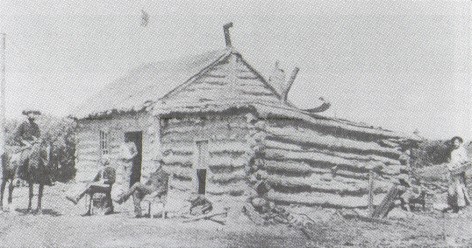
The Alberta Archives state this picture is at Swan River, SK
(Photo #B4432),
but the National Archives in Ottawa state that
it is the Humbolt telegraph
office (Photo #C-753).
The contract for the second section of line was let to Richard Fuller of
Hamilton, Ontario. This line extended from Livingston through Humbolt (the
crossing of the Battleford and Prince Albert trails), crossing the South
Saskatchewan River at Clarke's Crossing (18 miles below Saskatoon), and on to
Battleford. It extended from Battleford along the south side of the river to
Leduc (Alberta), which meant it did not connect Edmonton. It was completed in
November, 1876. Repair stations were located at Poplar Plains (50 miles west of
Pelly, Richard Matheson and Walter Salsbury, linemen), Humbolt, (George Weldon,
lineman), Battleford (John Little, superintendent, Thomas Dewan and Bernard
Tremont, linemen).
Francis J. Barnard, a Cariboo Road entrepreneur who ran the
famous "B.X. Express" stage coaches, was awarded the third and most
western contract. Barnard was an American, born in Quebec, and was one of many
who flocked to the gold fields of northern B.C. in 1859. (The contract has been
reported to cover the area from Fort Edmonton to Cache Creek, but this was still
4 years before Edmonton requested and obtained telegraphic connection, while the
Western Union [Collins'] line had been brought as far east as Kamloops by 1867.) This connecting line was to parallel the North Thompson River.
About halfway between Kamloops and Tete Jeune Cache, the famous cache of
McMicking insulators and wire was stored in preparation for building this
connecting line section. (See Canadian Insulator Collector, March/April 1995.)
For some reason the connector was never built. (It was still 7 years before the
connection would be made from Humbolt, Saskatchewan to the CPR at Qu' Appelle
Station.) Apparently more of these telegraph contracts were cancelled than were
actually constructed. Most people speculate that the telegraph line was to
follow ahead on the exact route of the proposed railway. This location is on the
"Yellowhead" route which was first surveyed for a cross-Canada wagon
road, later to be the CPR. The location was later changed in favour of Rogers'
Pass in the south. Because the supply depot location was only one-sixth of the
way between Kamloops and Edmonton, there may have been more depots at intervals
through the Yellowhead route.
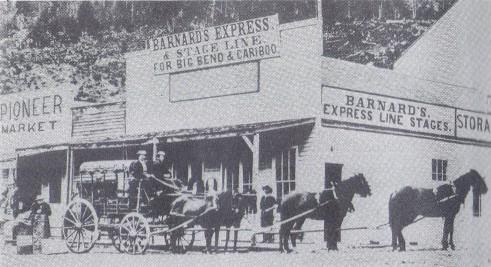
Barnard's express office in Yale in 1868.
The line west of Battleford was not used until 1877 when Richard Fuller hired
James McKernan to maintain the line from a point 30 miles west of Battleford to
its western terminus at Leduc. (James McKernan was one of the 500 men who
marched west as a member of the Mounted police three years earlier.) James
McKernan settled at Hay Lakes, about 30 miles east of Leduc, while his brother,
Robert McKernan, situated himself at Grizzly Bear Coulee, about halfway between
Edmonton and Battleford. These were repair stations only, no telegraph offices
were opened, although James McKernan knew the code and often received government
messages for the Mounted Police stationed at Fort Saskatchewan.
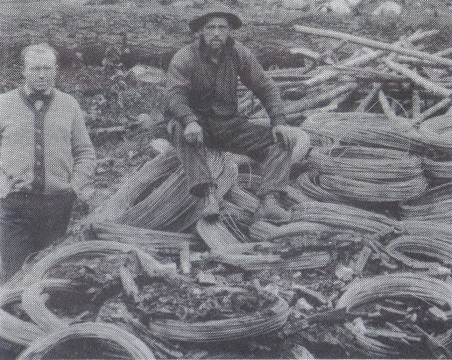
Wire Cache as discovered by the CNR construction crew on
the North Thompson
River in 1918. Note the threadless
McMicking insulators among the rolls of wire.
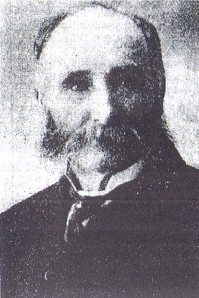 |
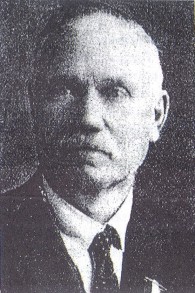 |
Thomas Dewan and James McKernan.
|
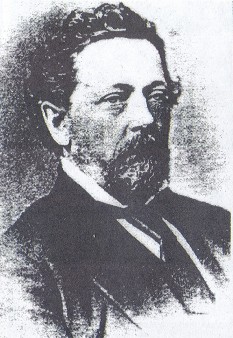 |
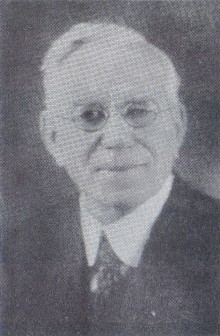 |
|
Francis J. Barnard and J. Stuart MacDonald. |
In 1878, the Hudson's Bay Post at Edmonton was becoming more of a village;
and its residents petitioned the Government to extend the telegraph service from
its terminus at Leduc. They offered to construct the line free of charge if the
government established an office. The contractor (Mr. Fuller) supplied the wire
and insulators for free, and the Hudson's Bay Company provided the poles and
most of the labor. The project was overseen by McKernan, and was completed and
operating on January 19, 1879. Upon completion of the line to Edmonton, the
contractors fixed the tariff at $3.00 for 10 words from Edmonton to Winnipeg,
$2.00 from Battleford to Winnipeg, and $1.00 from Edmonton to Battleford. The
press rate was 1/2¢ per word, the Herald and Bulletin using the wire for free.
During the years 1879-80, few settlers came to the region, and there was little
use of the telegraph.
The line was nothing but trouble from the beginning.
(Sounds like most of these early pioneer lines.) In the Eastern section, the
poles were poplar, an unsuitable wood. The wire was lighter than regular
telegraph wire and the insulators were smaller. On the plains, buffalo used the
poles as scratching posts and overturned them regularly. When the line ran
through uncut thick groves of small northern trees, the line went dead in wet
weather. With the linemen situated 100 miles apart, their only transportation being a buckboard and a single horse,
it was practically impossible to maintain continuous operation. Battleford,
however, had two dog sled trains for maintaining the line in winter. In spring
and summer, prairie grass fires were the main source of trouble, destroying
great numbers of poles as they progressed. The line actually worked well from
the first frosts of autumn to the spring thaw. The job of lineman during these
times was a particularly difficult one, far from trading posts or any source of
supply, there was little variety of food. A few cases of scurvy developed, the
victims going to Battleford in spring for treatment. While researching this
article, I came upon numerous accounts of frostbite, snow blindness, and heroic
acts of endurance.
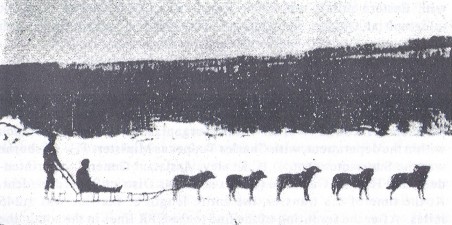
Repairing the telegraph line by dog sled in winter (near Battleford).
In the early 1880's, numerous surveying parties started dividing up the
prairie into sections and quarter sections of land in preparation of settling
farmers. As Battleford was then the capital and centre of activity, it also
became the gathering point for the surveying parties. On one occasion in
Battleford, while the line was being repaired, the operator constructed a sun
dial consisting of four rods. This soon became the standard time used in the
north, transmitted over the wire at regular intervals. Battleford was also the
location of the first Northern telegraphic weather reports (in the summer of
1879). The Western Union published a listing of all telegraph office activity
twice a month. The January 16, 1880 listing in the Journal of the Telegraph
shows several new offices in British North America. They were: Battleford, Fort
Edmonton, Humbolt, Hay Lakes, Lake Manitoba, Poplar Plain, Rennie, Ridout's
Hotel, Ross Land, and Swan River.
Mr. Fuller's original contract expired after two years, and all paid
employees of the telegraph were relieved. No steps were taken to immediately
reopen the line. Finally, a Mr. La Touche Tupper was sent out by the Government
to reopen the line for business and all interested former employees were
rehired.
Shortly after this, an announcement was made that the line west of
Humbolt would be abandoned in favour of a new line connecting Edmonton and
Battleford to the CPR telegraph system in the South. The work began in the
summer of 1882 at Troy, and later that year reached the Touchwood Hudson's Bay
post (later named Kutawa). In the interim, there was a 80 mile gap in the
telegraph between Humbolt and Kutawa, telegraph messages having to be carried on
foot. By bridging the gap, Edmonton and Battleford were able to keep in touch
with Eastern points with their system now connected to the CPR telegraph at Qu'
Appelle Station. This new line connected South Qu' Appelle, Fort Qu' Appelle,
Touchwood Hills, and crossed the Salt Plains to Humbolt. Here it joined the
original line built from Selkirk in 1874.
In the summer of 1882 the
responsibility for telegraph lines was transferred from the Department of
Railways and Canals to the Department of Public Works. Ottawa organized a
Telegraph Branch within the department, with Charles Tupper as Minister. F.N.
Gisborne was the Superintendent, D.H. Keeley, Assistant General Superintendent,
and Hartley Gisborne (F.N.'s son) was District Superintendent. At the time of
the transfer, the entire length of the line was 1,245 miles. After the rerouting
of the line to the CPR lines in the south, the total length was reduced to 975
miles.
During the summer of 1883 the residents of the settlement of Prince
Albert petitioned the Government to give them telegraph service. Similar to the
arrangement with Edmonton, the residents offered to construct the line to join
at the nearest point on the existing line. Construction was completed on
December 3, 1883 and the new branch line joined at Clarke's Crossing (where the
main line crossed the South Saskatchewan River). It was to extend all the way
to Prince Albert, but was only built to the Hudson's Bay Company post four miles
south of the settlement. This angered the settlers who proceeded to tear up
poles. Hartley Gisborne was visiting the site to install the telegraph set and
was threatened by angry residents. He quickly reported the incident to the
Minister at Ottawa, where a decision was made to go with the wishes of the
settlers, and the office was moved into the village.
Also in 1883, the station
at Humbolt was closed. Mr. Weldon and family left, becoming operator for the CPR
telegraph at Grenfell. Mr. Lindenburg was sent to Touchwood Hills to open the telegraph station there,
called Kutawa, 70 miles from Qu' Appelle and 70 miles from Humbolt.
An office
was opened at Clarke's Crossing in 1884. Richard J. Molloy, a newspaper
publisher from P.E.I., was the first agent there. When the Government decided to
grant representation to these territories, Molloy became the Conservative
nominee for Saskatchewan. He remained in the telegraph service for many years
and eventually took a position in Qu' Appelle with the CPR.
In the fall of 1884
the Department decided to change the route of the line between Battleford and
Edmonton. There was only one small settlement on the south side of the river at
the time (Bresaylor), while Indian Agencies at Onion Lake and Saddle Lake on the
north side were without communication of any kind. It was then decided that the
new location of the line would be from Battleford, crossing the river at Fort
Pitt, with offices at Pitt, Moosawa, Saddle Lake, Victoria (now Pakan), and Fort
Saskatchewan. The rebellion broke out before this change, so construction was
commenced in the spring of 1886. Between Battleford and Pitt 15 foot high hollow
iron poles, 2-1/2 inches round, were used with a double ground plate to hold
them firmly. The experiment was a success, the poles withstanding prairie fires
and lightning. These remained in place until abandonment in 1926. Fredrick N.
Gisborne, Hartley's father, actually received Canadian patent #22449 for the
invention of these iron poles. By 1888, 3500 of these poles were in use. From
Pitt to Edmonton the line was built with tamarac poles. F. N. Gisborne, in his
report to the Minister on North West lines in November 1883, called these poles
"Hacmatack". (See Canadian Insulator Collector January 1995, March
1995, May 1995 for Gisborne's full 1883 report.)
In March 1885 came the North
West rebellion. Without the telegraph, the condition of affairs throughout the
whole North country would have been unknown to the Mounted Police who were too
few and too occupied with the newly built railway in the South. It was the
rebellion which proved the tremendous value of the telegraph line to Ottawa, and
finally, its construction and difficult maintenance was justified. The wire was
broken in several places during the rebellion, and linemen risked their lives to
venture out to make repairs.
There are reports of one telegrapher being held
captive and another killed during the rampage. One of these men, Bernard Tremont
(also known as Barney Freeman) was a Belgian. Before coming to Canada he lived
in Wyoming with his brother ranching cattle. He frequently expressed his
contempt for Indians, as his brother was killed at his side by one while driving
cattle in Wyoming. He was a lineman during the period when Fuller had his contract and then
remained with the telegraph service until 1884. He then went into business with
fellow lineman Thomas Dewan and established a ranch a few miles out of Battleford. Due, doubtless, to his feelings regarding Indians, he refused to leave his
ranch when the rebellion broke out and so became one of the first victims when
the Indians went on the killing rampage. He was killed in March of 1885. A
tablet was placed in his memory by his fellow linemen in March 1886 at St.
George's Episcopal Church in Battleford.
With all the trouble in the northern
part of the territories, the Government quickly built telegraph lines in the
south, linking numerous small settlements. Lines were strung from Calgary to
Macleod, Calgary to Lethbridge, and Moose Jaw to Wood Mountain. The lines were
completed by the end of June 1886. In 1877 Sitting Bull surrendered (to Major
Crozier after the Custer massacre) by walking into the telegraph & police
office at Wood Mountain.
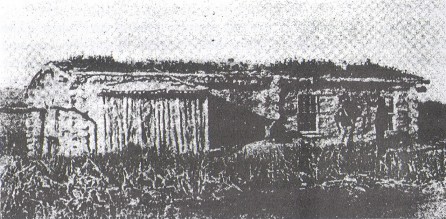
Wood Mountain telegraph office.
Shortly after the opening of the office at Wood Mountain, the Department sent
a pair of wooden telephones for experimental purposes. One was installed at Wood
Mountain, the other at Moose Jaw. These were the first telephones to be used in
the territories, and apparently worked quite well. In September of 1886, an
office was opened at Henrietta, near the elbow of the North Saskatchewan river,
with a youthful 16 year-old L.P.O. Noel as the agent.
Hartley Gisborne retired
as District Supervisor in 1897, and was replaced by J. Stuart MacDonald, who in
1905, was promoted to be General Inspector of all Western Lines.
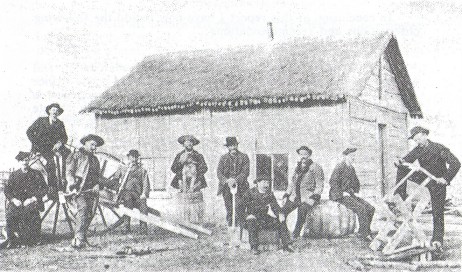
Residents of Battleford in 1884. Hartley Gisborne is the
person standing
behind the upright barrel near the center
of the picture. There is a large dog
sitting on the barrel.
Several more lines were connected to the Dominion system; one from Edmonton
to Hudson's Hope, BC, the head of navigation on the Peace River. This line
served many settlements along the way: Fort St. John, Pouce Coupe, Grand
Prairie, Peace River, and others. Another line extended down the river from
Athabasca to McMurray, while a second line from Athabasca ran Eastward to Lac la
Biche, serving points in between. One long line ran from Battleford north to
Isle la Crosse, over 300 miles.
The fact that commercial telegraph companies
were starting to occupy the districts once served by the government lines
determined that the latter were gradually abandoned and in some cases,
dismantled. The outlying territories were served by the Government lines for
many more years, though. In these remote areas there was no interest by the
commercial companies to construct lines. The commercial companies didn't
undertake this work until the settlements grew to become a size which warranted
some financial return on their investment.
Following is the observations and
recommendations section from F. N. Gisborne's report of November 8, 1883. He
traveled west with his son, Hartley, that summer to inspect the line and report
back to the Minister. His son remained in Battleford as District Superintendent
of Lines.
In conclusion of this report I have now to add the following observations and
recommendations:
1. That the telegraph line between Qu'Appelle Station and Humboldt, 151
miles, and between Clark's Crossing and Prince Albert, 95 miles, being newly
built, although of poplar poles, is in good order; the wire, No.8, weighing 376
lbs. per statute mile, and the brackets and insulators being of good quality.
2. That the line between Humboldt and Clark's Crossing, 60 miles, has been
rebuilt for 14 miles, and repaired for 46 miles with alternate new poles, the
wire being No.9, weighing 303 lbs. to the mile, but the brackets being old, and
the insulators of small and poor description.
3. That the line from Clark's Crossing to Battleford, 155 miles, is in a bad
condition, the poles (poplar) being rotten; the wire, No.9, good, but the
insulators and brackets poor. It has, however, been placed in as good order as
practicable by three repairers, for winter service.
4. That from Battleford to Edmonton, 302 miles, the line is upon its last
legs, the poles being rotten, the wire, beyond twenty-five miles west of
Battleford being No. 11, weighing 199 lbs. to the mile and much too weak for
service, many of the brackets split, and the insulators of the poorest
description.
5. That throughout the entire line there was either a marked deficiency or
total absence of all necessary material for the repair and maintenance of the
line; the office instruments being also ineffective.
6. That the telegraph line is rarely near the travelled trail. as it was
originally erected, and has since been maintained upon the abandoned surveyed
route of the Canadian Pacific Railway, and in consequence passes through and
over lakes, muskegs, and bluffs of timber which have since grown up and now bear
upon the wires. The inconvenience and greatly increased difficulty of repairing
such a line can hardly be over-estimated, for even a poor trail is luxury in
comparison with a drive over rough ground perforated with innumerable badger and
gopher holes.
7. That the total revenue of the line, when transferred to the Department of
Public Works, did not exceed $50 per month, versus an expenditure of over $690
per month.
8. That it was the unanimous opinion of settlers throughout the North-West
that in no other manner could the Dominion Government, at such small comparative
cost, so conduce to the welfare of the people, and settlement of the land, as by
the establishment of an effective system of telegraphy, connecting outlying
localities with the capital of Manitoba and Eastern Canada.
RECOMMENDATIONS
1. That in all future telegraph lines erected by Government in the North-West
No.6 galvanized iron wire, weighing 570 pounds per statute mile, and equal to a
breaking strain of 1,850 lbs., be used; together with first-class insulators and
good screw, oak or iron brackets or pins.
2. That wherever practicable hacmatack or spruce poles be obtained, although
at a cost of not exceeding $2 each delivered on the ground, rather than use
poplar, which eventually costs much more during the life-time of the better
wood. And that light iron or steel poles, at a cost of not exceeding $3 each
delivered on the ground, be used throughout prairie sections which are distant
from spruce or hacmatack groves of timber.
3. That telegraph stations be established at not over 100 miles apart, and
that shelter huts for repairers' use be erected within 33 miles of each station,
or each other.
4. That the lines between Qu'Appelle Station on the Canadian Pacific Railway,
via, Touchwood, Humboldt and Clark's Crossing to Battleford, and between Clark's
Crossing and Prince Albert, be maintained in effective working order, the poles
being gradually replaced by a better class of timber or iron, as required.
5. That the 24 or 25 miles of No.9 wire, west of Battleford be taken down,
and that the line thence to Edmonton, which passes through an almost entirely
uninhabited country, one not likely to be settled or traversed by a branch
railway for many years, and far south of the North Saskatchewan route of travel
via Fort Pitt, be abandoned in toto.
6. That the offer of the inhabitants of Saskatchewan and of St.,Albert to
provide spruce and hacmatack poles, be accepted, and that a line be erected to
those settlements, 18 miles and 9 miles, respectively, from Edmonton,
7. That an entirely new line, furnished with hacmatack and spruce poles,
which contractors offer to deliver along the trail for $1.40 each, be erected
between Edmonton and Calgary, the distance being 180 to 185 miles.
8. That prior to the erection of such telegraph line, a new main trail
probably approximate to the present one though shorter, be surveyed out between
Edmonton and the most convenient station for freighters, at or near Calgary.
Finally I may add that should the foregoing recommendations meet with the
approval of the Government, I am of opinion that, when established, such lines
would not only be self-supporting, but also at a comparatively small cost, tend
very much to the prosperity of the inhabitants, and also to the more rapid
settlement of the North-West; nor should it be forgotten that the Calgary to
Edmonton line would be a section of its future expansion to the Peace River
district.
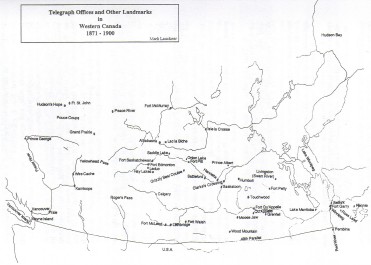
Medium Image (66 Kb)
Large Image (169 Kb)
"Numerous attempts have been made in recent years by insulator
collectors to locate this old pioneer threadless line.... "
The Dominion (Battleford) Telegraph Part II is scheduled for next month.
|
